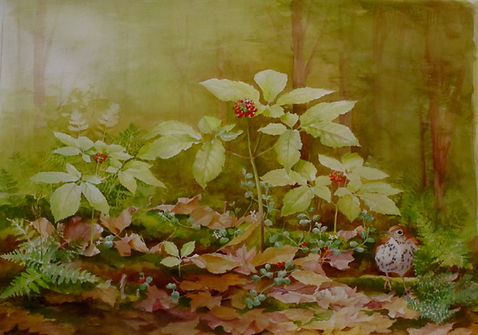CITES regulates the export of roots of natural, ‘wild’, unplanted and uncultivated populations of ginseng, as well as the export of roots of cultivated ginseng. But ginseng exists in a wide variety of growing conditions, ranging from intensive cultivation under shade cloth (Ontario, Wisconsin, and British Columbia, being centers of this practice), to ‘woods grown’ in cultivated beds, to ‘wild simulated’. These growing practices can blur the distinction between cultivated and ‘wild’ ginseng, resulting in many heated disagreements about how to regulate ginseng trade, but shedding very little light.
Those who do not understand the nature of genetics may wildly underestimate its importance in many ways. For instance, some will claim there is ‘no such thing’ as a wild ginseng population (all of them were planted by somebody!). Others will advocate broadcasting seeds (inevitably from shade-grown cultivated plants) from helicopters to restore ginseng populations across the forest, not recognizing that there may be critically important genetic differences between wild and shade-grown cultivated seed sources.
Though ginseng can pollinate itself, crossing with neighbors also occurs, providing a way for maladapted genes to enter natural populations if cultivated plants are introduced nearby.
Science has begun to shed some light on these issues;

Below average flower bud of wild American ginseng. Credit: McGraw Labs, WVU
First; using modern genetic tools, we now know that most ‘natural’ populations are not contaminated with genes from cultivated seed sources. (1,2,3,4) Thus, claims that all populations are unnatural are clearly false.;
Second; experiments have shown that crosses between plants from cultivated and wild seed sources are possible (they have not yet become separate species), and produce genetically distinct offspring.(5);
~No one has yet examined whether such crosses introduce maladaptive* genes into natural populations, but there is every reason to believe that in theory, they could – the traits under selection in cultivation (rapid growth, ability to grow quickly in response to nutrient additions, low defenses against herbivory and fungal diseases) are precisely the wrong traits to allow persistence in the wild.;
~Using the precautionary principle, which is the centerpiece of Aldo Leopold’s philosophy of conservation biology, we discourage mixing of gene pools of natural and cultivated seed sources.;
By the same token, ginseng has all the hallmarks of a locally adapted species,(6) so we encourage those attempting wild simulated ginseng husbandry to use, wherever possible, local seed sources, to ensure success, and minimize genetic pollution. Wild simulated ginseng can potentially reduce the pressure on wild populations of American ginseng by increasing the supply of roots to meet the demands of the Asian market. Therefore, when local seed sources are used, wild simulated production can be a conservation tool.
maladaptive*- meaning ‘bad’ for the growth, survival, and reproduction of the ‘native’ plant.
References
(1) Schluter and Punja 2002. Genetic diversity among natural and cultivated field populations and seed lots of American ginseng (Panax quinquefolius L.) in Canada.
(2) Grubbs and Case 2004. Allozyme variation in American ginseng (Panax quinquefolius L.): Variation, breeding system, and implications for current conservation practice.
(3) Schlag and McIntosh 2012. RAPD-based assessment of genetic relationships among and within American ginseng (Panax quinquefolius L.) populations and their implications for a future conservation strategy.
(4) Young et al. 2012
(5) Mooney and McGraw 2007. Effects of self-pollination and outcrossing with cultivated plants in small natural populations of American ginseng, Panax quinquefolius (Araliaceae).
(6) Souther and McGraw 2011. Evidence of local adaptation in the demographic response of American ginseng to interannual temperature variation.
What can you do about non-local seed?
(1) If you are a landowner, carefully consider the existence of potentially wild american ginseng on your property before planting non-local seed and mixing the genetics.
(2) Try to track down local planting stock, if attempting to grow ginseng. If none is available, try to keep patches from non local seed away from native populations to prevent intermixing.
Mature American ginseng berries.
batcavebotanicals, 2014
%25252520(Copy)_edited_edited_edited.jpg)
